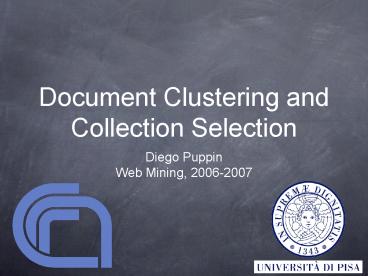Document Clustering and Collection Selection - PowerPoint PPT Presentation
Title:
Document Clustering and Collection Selection
Description:
referrer, related. query terms. How To Doc-Partition? Random doc assignment Query broadcast ... referrer, related. query terms. query mapping. Developments ... – PowerPoint PPT presentation
Number of Views:45
Avg rating:3.0/5.0
Title: Document Clustering and Collection Selection
1
Document Clustering and Collection Selection
- Diego Puppin
- Web Mining, 2006-2007
2
Web Search Engines Parallel Architecture
- To improve throughput, latency, res. quality
- A broker works as a unique interface
- Composed of several computing servers
- Queries are routed to a subset
- The broker collects and merges results
3
(No Transcript)
4
(No Transcript)
5
(No Transcript)
6
(No Transcript)
7
Doc-Partitioned Approach
- The document base is split among servers
- Each server indexes and manages queries for its
own documents - It knows all terms of some documents
- Better scalability of indexing/search
- Each server is independent
- Documents can be easily added/removed
8
Term-Partitioned Approach
- The dictionary is split among servers
- Each server stores the index for some terms
- It knows documents where its terms occur
- Potential for load reduction
- Poor load balancing (some work...)
9
Some considerations
- Every time you add/remove a doc
- You must update MANY servers
- With queries
- only relevant servers are queried but...
- servers with hot terms are overloaded
10
How To Load Balance
- Put together related terms
- This minimizes the number of hit servers
- Try to put together group of documents with
similar overall frequence - Servers shouldnt be overloaded
- Query logs could be used to predict
11
Multiple indexes
- Term-based index
- Query-vector or Bag-of-word
- Hot text index
- Titles, Anchor, Bold etc
- Link-based index
- It can find related pages etc
- Key-phrase index
- For some idioms
12
query terms
terms
links
hot
query terms
referrer, related
13
How To Doc-Partition?
- Random doc assignment Query broadcast
- Collection selection for independent collections
(meta-search) - Smart doc assignment Collection selection
- Random assignment Random selection
14
1. Random Broadcast
- Used by commercial WSEs
- No computing effort for doc clustering
- Very high scalability
- Low latency on each server
- Result collection and merging is the heaviest part
15
Distributed/Replicated Documents
16
2. Independent collections
- The WSE uses data from several sources
- It routes the query to the most authoritative
collection(s) - It collects the results according to independent
ranking choices (HARD) - Example Biology, News, Law
17
(No Transcript)
18
3. Assignment Selection
- WSE creates document groups
- Each server holds one group
- The broker has a knowledge of group placement
- The selection strategy routes the query suitably
19
(No Transcript)
20
4. Random Random
- If data (pages, resources...) are replicated,
interchangeable, hard to index - Data are stored in the server that publishes them
- We query a few servers hoping to get something
21
(No Transcript)
22
CORI
- The Effect of Database Size Distribution on
Resource Selection Algorithms, Luo Si and Jamie
Callan - Extends the concept of TF.IDF to collections
23
(No Transcript)
24
(No Transcript)
25
CORI
- Needs a deep collaboration from the collections
- Data about terms, documents, size
- Unfeasible with independent collections
- Statistical sampling, Query-based sampling
- Term-based no links, no anchors
- Very large footprint
26
(No Transcript)
27
Querylog-based Collection Selection
- Using Query Logs to Establish Vocabularies in
Distributed Information Retrieval - Milad Shokouhi Justin Zobel S.M.M. Tahaghoghi
Falk Scholer - The collections are sampled using data from a
query log - Before Queries over a dictionary (QBS)
28
- Recall
- Number of found documents (not for web)
- Precision at X (P_at_X)
- Number of relevant documents out of the first X
results (X 5, 10, 20, 100) - Average precision
- Average of Precision for increasing X
- MAP (Mean Average Precision)
- The average over all queries
29
(No Transcript)
30
And now for something completely different!
31
Important features
- It can use any underlying WSE
- Links, snippets, anchors...
- Good or bad as the WSE it uses!
- Small footprint
- It can be added as another index
32
query terms
terms
links
hot
query-vector
query terms
referrer, related
query mapping
33
Developments
- Query suggestions
- The system finds related queries
- Result grouping
- Documents are already organized into groups
- Query expansion
- Can find more complex queries still matching
34
(No Transcript)
35
(No Transcript)
36
(No Transcript)
37
Still missing
- Using the QV model as a full IR model
- Is it possible to perform queries over this
representation? - New query terms cannot be found
- CORI should be used for unseen queries
- Better testing with topic shift
38
Possible seminars/projects
- Advanced collection selection
- Statistical sampling, Query-based sampling
- Partitioning a LARGE collection (1 TB)
- Load balancing for doc- and term-partitioning
- Topic shift
- Query log analysis































